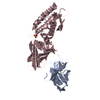+Search query
-Structure paper
| Title | Biogenesis and structure of a type VI secretion membrane core complex. |
|---|---|
| Journal, issue, pages | Nature, Vol. 523, Issue 7562, Page 555-560, Year 2015 |
| Publish date | Jul 30, 2015 |
 Authors Authors | Eric Durand / Van Son Nguyen / Abdelrahim Zoued / Laureen Logger / Gérard Péhau-Arnaudet / Marie-Stéphanie Aschtgen / Silvia Spinelli / Aline Desmyter / Benjamin Bardiaux / Annick Dujeancourt / Alain Roussel / Christian Cambillau / Eric Cascales / Rémi Fronzes /  |
| PubMed Abstract | Bacteria share their ecological niches with other microbes. The bacterial type VI secretion system is one of the key players in microbial competition, as well as being an important virulence ...Bacteria share their ecological niches with other microbes. The bacterial type VI secretion system is one of the key players in microbial competition, as well as being an important virulence determinant during bacterial infections. It assembles a nano-crossbow-like structure in the cytoplasm of the attacker cell that propels an arrow made of a haemolysin co-regulated protein (Hcp) tube and a valine-glycine repeat protein G (VgrG) spike and punctures the prey's cell wall. The nano-crossbow is stably anchored to the cell envelope of the attacker by a membrane core complex. Here we show that this complex is assembled by the sequential addition of three type VI subunits (Tss)-TssJ, TssM and TssL-and present a structure of the fully assembled complex at 11.6 Å resolution, determined by negative-stain electron microscopy. With overall C5 symmetry, this 1.7-megadalton complex comprises a large base in the cytoplasm. It extends in the periplasm via ten arches to form a double-ring structure containing the carboxy-terminal domain of TssM (TssMct) and TssJ that is anchored in the outer membrane. The crystal structure of the TssMct-TssJ complex coupled to whole-cell accessibility studies suggest that large conformational changes induce transient pore formation in the outer membrane, allowing passage of the attacking Hcp tube/VgrG spike. |
 External links External links |  Nature / Nature /  PubMed:26200339 PubMed:26200339 |
| Methods | EM (single particle) / X-ray diffraction |
| Resolution | 1.51 - 11.5 Å |
| Structure data |  EMDB-2927:  EMDB-2928:  PDB-4y7l:  PDB-4y7m:  PDB-4y7o: |
| Chemicals |  ChemComp-GOL:  ChemComp-ZN:  ChemComp-HOH:  ChemComp-SO4: |
| Source |
|
 Keywords Keywords |  MEMBRANE PROTEIN / Type 6 secretion system / Alpha-beta fold / MEMBRANE PROTEIN / Type 6 secretion system / Alpha-beta fold /  periplasmic protein / periplasmic protein /  SIGNALING PROTEIN SIGNALING PROTEIN |
 Movie
Movie Controller
Controller Structure viewers
Structure viewers About Yorodumi Papers
About Yorodumi Papers





